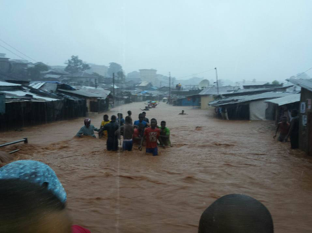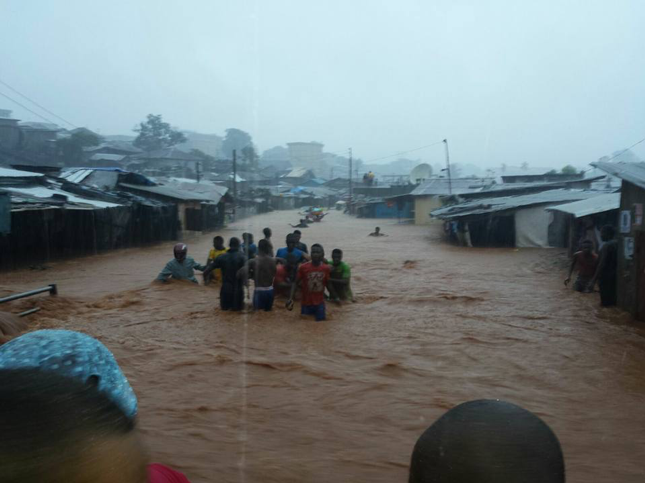
By: Sulaiman Stom Koroma
The rainy season is here again, a time of the year when some residents of Kroo Bay sit on tenterhooks because of the perennial floods they endure. The rains at times can be aggressive and very dangerous, most times killing people and leaving many homeless. Properties are also left unaccounted for.
For those who do not suffer directly from the rains because of their locations, the poor drainages and motorists among them will nonetheless encounter the inconveniences of flooding on some roads in the city in their daily activities. With the challenges of a poor individual forecast of the weather clemency, the people are left vulnerable with whatever the season holds. The streets of Freetown are left flooded creating economic loss and damages to vehicles.
According to the Environmental Protection Agency (EPA) poor waste management, construction of building at areas that are not ideal, the proximity of Freetown to the sea are all factors of flooding: “there are certain communities in Freetown which are very close to the sea and are affected by sea-level rise, equally so, the way we treat our wetlands i.e. the way we deplete our mangroves and forests leaves them in a state wherein they can no longer hold water and when it rains it lands directly into the low lands resulting to flooding” said James Tamba Kamara Assistant Director, Public Relations Environmental Protection Agency Sierra Leone.
Many years after the worst rainy season disaster was recorded in Freetown, it’s as if nothing was learned out of that, as the same situation continues unabated, people still live in slum areas waiting for disaster which when it happens will be cataclysmic. It could be recalled that on 14 August 2017, a massive landslide occurred at Regent on the outskirts of the capital Freetown. It was believed that the landslide developed into a debris flow that traveled 6km through the city and out to the coast killing approximately 1,141 people, displacing a further 5,000 and leaving the whole place devastated.
At this time of the year, the engineering deficiencies of road construction in some parts of the city become visible. Some parts of the city’s roads have become notorious for trapping rainwater in large volumes when it rains and, of course, impeding vehicular traffic. Rains pouring through the hills fall through poor drainages and flows into streets and houses.
Freetown’s population is said to be over two million. This number has increased from time to time since Independence in 1961. During the 1990s, because of the civil war in the country, many people fled to the capital, Freetown. According to Musa Kamara, a journalist working for Radio Democracy in Freetown, he said that: “Due to a large number of people in the capital, house rentals became a thorn in the flesh. After the war, 90% of those that came to Freetown never returned, some because of the job opportunities in Freetown which could not be provided for them where they came from, and for others, it was a discovery of a new home”.
As years go by, housing became a problem that saw a tremendous increase in the cost of “house rent”. Many people who could not afford the huge cost of “house rent”; turned to the forest areas as a solution, therefore, they began to build houses in slums and on hillside areas thereby extending the city from its original demarcation, he said.
Unfortunately, the expansion was not done with any urban strategy or plan in place. Dr. Joe Doherty, a geographer at the University of St Andrews, notes “spontaneous expansions are the order of the day. Everyone goes about putting structures virtually anywhere without proper coordination and planning”.
Sierra Leone was ranked 138 out of 172 in the World Risk Index of countries prone to natural disasters. Like Sierra Leone, Bangladesh, and Burkina Faso were among the three worse countries where disasters are bound to happen. And research by the World Bank suggests that drier dry seasons and wetter wet seasons are only likely to increase in frequency in coastal cities. Even though there is frequent flooding during August and September yet still, there seem to be water shortages in March especially in Freetown. In some communities in Freetown, water pipes are cut as people desperately search for water, equally so, some households will make arrangements with Guma Valley, the main water company, to have water delivered to their tanks at home.
The flooding situation became worse on September 16th, 2015 when Sierra Leone’s capital city, Freetown, was hit by unprecedented floods caused by torrential rainfall of 600 mm in only 5 hours. The normal average annual rainfall for Freetown is about 2,945 mm, and the total for the wettest month, August, averages about 790 mm. The Government and other NGOs’ state of preparedness and resilience for such disasters as well as the role of volunteers in communities is always tested to its peak. The country was seriously stretched, with capacity, accommodation, and finances. A day the country will never want to see again.
Kroo Bay is one of the largest coastal slums with an estimated population of 6,000 to 8,000 and has flooded every year since 2008. Despite series of measures and promises from both the Central and Local governments that they will find a solution, that promise is still farfetched. The previous government through a State House press release on the 25th September 2015 just after the flood incident noted that flood victims and other slum dwellers have consented to be relocated to new and safer settlements. The release continued that the government has already identified Six Mile as one of the suitable locations for resettlement of the first set of flood victims ensuring to make life better for them, by creating an adaptable environment and provide them with the necessary social facilities, including markets, schools, hospitals that will encourage victims to live there.
At Kroo Bay where people live at the bottom of a valley in Freetown, they are separated from the sea by a rubbish dump. During the rainy season, the area is badly affected by intense rain, this could happen two or more times during the rainy season. But with all these challenges they face, they persistently and deliberately force their stay.
But with all this, resident Isatu Turay, who is a petty trader said: “I love Kroo Bay although during the rains we lost almost everything we have when there is flooding, the community is washed away, we survive through the help of God because the majority of us here are poor and barely get our daily bread; livestock are lost, homes are destroyed and sometimes people lose their lives. We suffer the most when the flooding happens at night” she said.
For many years now, both the local and central government suggested relocating the whole community, but this idea was frowned upon by those living in that area. Many of them claimed that because their grandparents and parents had lived there, they are therefore more than accustomed to living there.
Mohamed Kamara has lived in Kroo Bay since birth. He said it will be difficult for him to leave Kroo Bay because there is no other place in Sierra Leone that feels comfortable for him “I was born and bred here, I am used to this place more than any other, relocating me is like putting me in prison” he said
Years back, most of the residents of Kroo Bay had asked the government to take the slum from the people and not the people out of the slum. This assertion created a lot of debate among people, with many believing that the area should not be used for habitation and that relocation is the only solution, while others think that the government should control the drainage issues and allow the residents to continue staying there. “From an environmental point of view, Kroo Bay is not a suitable place to live, because Kroo Bay has been recorded as one of the environmental disaster prone areas and so it is really not appropriate and conducive for human habitation,” says James Tamba Kamara, Deputy Director, Public Relations, EPA-SL.
According to the former Vice President of the Republic of Sierra Leone, Victor Bockarie Foh during an engagement with flood victims at the National Stadium during the September 2015 flooding, he said: “We are finding a permanent solution to the problem by relocating all flood victims from disaster-prone slums to more conducive places,” he said.
Charles Carew is a youth residing in Kroo Bay. “Some of us would not be comfortable relocating to any settlement other than here,” Charles said. “Government should remove the slum from the people instead of removing the people from the slum.” “Some of us are already established and doing business here. We fish here and we do boat transportation at sea, and would that be provided for us?” Carew asked.
According to Shack/Slum Dwellers International (SDI) “Freetown is home to at least 61 informal settlements, many of which are perched on the last vestiges of land before the sea. Their names evoke this proximity to water: Kroo Bay, Susan’s Bay, Magazine Wharf and Queen Elizabeth II Quay”. The forest is disappearing slowly but at an alarming rate and the impact on the city has been felt many times, but still not much has been done about it.
.
In 2012, an economist wrote, “there is little excuse for drifts of rubbish in a city [Freetown] with massive underemployed manpower”. Unfortunately, and unnecessarily, this remains the reality today. Youth unemployment is estimated at over 60%. In 2013, a 20-year contract was signed with MASADA Energy to carry out waste management in the city, but waste still piles up on the streets. Some question the capability of MASADA”. Dr. Monde views waste management as an issue that has been “politicized and very poorly handled”.
“The waste issue is multi-faceted. Freetown only has two dumpsites, at Kissy and King Tom, both of which are at capacity and located in residential areas. The Freetown Development Plan recommended the sites be closed in 2009, as they posed significant health risks to communities, and identified new dumps outside the city. These recommendations have not yet been acted upon. Even if waste collection improves, the question of where to dispose of it remains unresolved”.

To stop all this, the idea of setting up the Environmental Protection Agency became a necessity. So in 2008 the Environmental Protection Agency act was established and became operational in 2009. It was established to create and enforce a strict regulatory framework for environmental regulations in Sierra Leone. Part of its mandate involves formulating a national climate change policy and establishing a national secretariat for climate change, which became operational in 2012.
In 2008, Mary Mye-Kamara, then Director of Disaster Management within the Sierra Leonean government, stated that “massive rural to urban migration in recent years, deforestation and poor drainage makes the city’s coastal communities most vulnerable”. Seven years on questions need to be asked about what is being learned – and done – by the government for the urban majority.
Developing a long-term plan for the city that is climate-sensitive, addresses waste disposal, is appropriately financed, and designed in consultation with residents of informal communities should be a priority. The current ad-hoc approach is utterly failing the poorest members of society. “Government recognition of the importance of urban planning is vital. It could acknowledge this by spending more on educating a future generation of Sierra Leone planners,” says Joseph Macarthy (who is himself involved in efforts to teach the subject at Njala University in Freetown).
Cabinet has recently approved the Development Induced Resettlement Policy and the Policy will be followed by a Development Induced Resettlement Law. The Government of Sierra Leone through the Ministry of Environment with support from the Millennium Challenge Coordinating Unit (MCCU) made that possible. This Policy and the Law will guide the planning and implementation of resettlement which occurs when certain development projects are undertaken by the Government or Private Companies. For example, projects such as Road Construction, Mining, Energy, Agriculture, and Hydroelectricity, etc.
The dangers caused by the rains are enormous, lives have been lost, property destroyed, and the economy badly affected. Year after year the population in those areas keeps growing defying both the local and central government’s call for relocation and the continued destruction of forest areas.
Recently, the Minister of Lands Housing and Country Planning was in Accra according to the Ministry’s PR unit, the invitation was from one of Ghana’s biggest real-estate developers, JL Properties, to ascertain the company’s readiness to invest in Sierra Leone.
The Minister they say is keen to develop micro-cities in degraded land sites or brownfields as captured in the government’s Medium Term Development Plan.
“My intention is to develop sustainable and affordable housing units in well-planned communities, with a special focus to transform slum communities and dumpsites into high peak planned settlements,” Dr. Senesie disclosed, whilst expressing delight that JL Properties is just the right match for such ventures as evident in its records of transforming brownfields into planned gated communities.
Recently, the ministry of Lands revealed that they will build about 10,000 houses for civil servants in the country, but did not say any of those will be allocated to slum dwellers.
Meanwhile, the rains continue to cause havoc year after year but lessons are not taken from the destructions caused. Is the assertion “take the slum out from the people or the people out of the slum” work? Or it will be the other way round. With the resettlement bill now a work in progress, the government’s commitment to relocate, it’s just a matter of time now.



